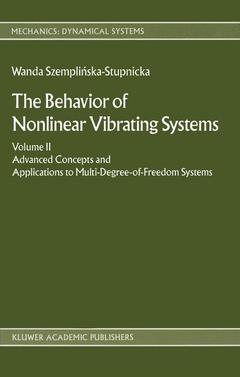Description
The Behaviour of Nonlinear Vibrating Systems, 1990
Volume II: Advanced Concepts and Applications to Multi-Degree-of-Freedom Systems
Mechanics: Dynamical Systems Series, Vol. 12/13
Language: English
Publication date: 08-2012
336 p. · 15.5x23.5 cm · Paperback
336 p. · 15.5x23.5 cm · Paperback
Description
/li>Contents
/li>
The purpose of this book is to provide students, practicing engineers and scientists with a treatment of nonlinear phenomena occurring in physical systems. Although only mechanical models are used, the theory applies to all physical systems governed by the same equations, so that the book can be used to study nonlinear phenomena in other branches of engineering, such as electrical engineering and aerospace engineering, as well as in physics. The book consists of two volumes. Volume I is concerned with single degree-of-freedom systems and it presents the fundamental concepts of nonlinear analysis. Both analytical methods and computer simulations are included. The material is presented in such a manner that the book can be used as a graduate as well as an undergraduate textbook. Volume II deals with multi-degree-of-freedom systems. Following an introduc tion to linear systems, the volume presents fundamental concepts of geometric theory and stability of motion of general nonlinear systems, as well as a concise discussion of basic approximate methods for the response of such systems. The material represents a generalization of a series of papers on the vibration of nonlinear multi-degree-of-freedom systems, some of which were published by me and my associates during the period 1965 - 1983 and some are not yet published.
1/Normal Oscillations in Autonomous Conservative Systems.- 2/Normal Oscillations of Elastic Nonlinear Continuous Systems.- 3/Free Oscillations with Arbitrary Initial Conditions.- 4/Harmonic Solution in Nonautonomous Systems and Its Local Stability.- 4.1. The Ritz method and variational coupled Hill’s equations.- 4.2. The first order unstable regions by the perturbation procedure based on the Floquet theory.- 4.3. The first order unstable regions by the asymptotic and averaging method.- 4.4. First order unstable regions of harmonic solution in a two- degree-of-freedom system — theoretical and computer simulation analysis.- 4.5. Harmonic plus constant term solution — systems with quadratic nonlinearity.- 5/Principal Resonances.- 6/Principal Resonances — Examples of Theoretical and Computer Simulation Analysis.- 6.1. Two-degree-of-freedom systems — problem of coupling of normal coordinates.- 6.2. Three-degree-of-freedom systems — the single nonlinear mode method.- 6.3. Homogeneous system with two-degrees-of-freedom.- 7/Secondary Resonances (Periodic and Almost-Periodic).- 8/Internal Resonances.- 9/Parametric Resonances.- References.
© 2024 LAVOISIER S.A.S.





